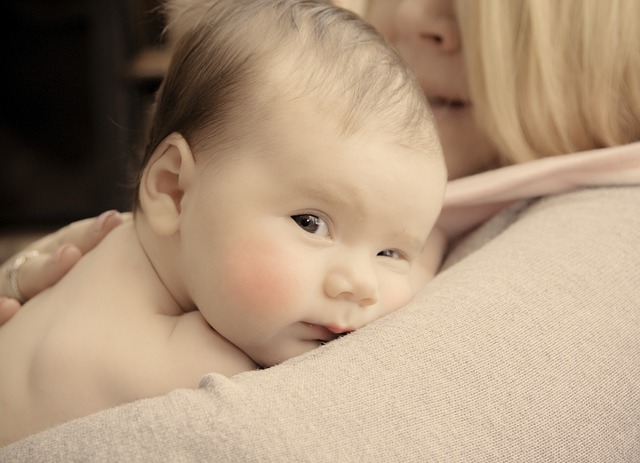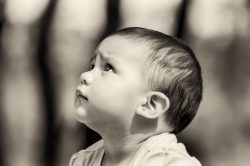Infant vision: development by months, features
In anticipation of the long-awaited meeting with a newborn son or daughter, every parent tries to imagine how they will lovingly and tenderly gaze into the baby’s eyes and enjoy their responsive gaze. But it doesn’t always work out that way: contrary to expectations, the baby spends most of the time with their eyes closed, squinting like a kitten, as if the sunlight causes discomfort.

Table of Contents
Sometimes the infant looks towards the source of light without paying much attention to their surroundings. This is due to the immaturity of the visual organs at this age.
Like any aspect of development, the formation of a baby’s visual abilities largely depends on the tactics chosen by their parents. Here are the key rules to follow from the first days of the child’s life:
- good lighting in the room where the newborn is kept;
- toys that correspond to the age of the child;
- systematic exercises that will take parents no more than a few minutes 3-4 times a day.
Baby’s first glance
In the first days after birth, a baby’s vision is characterized by the manifestation of unconditional reflexes: the reaction of the pupils to light and the direction of the gaze toward the source of light. The baby begins to react to bright light even before birth, at 28 weeks of pregnancy. However, although light sensitivity is already present in the first days of life, it is not yet sufficiently developed and only reaches 2/3 of the “adult” level by 6 months.
Central vision
The development of central vision, responsible for recognizing the shape of objects, begins at 2 or 3 months. The degree of formation of this visual function is visual acuity, which is normal at a level of one, or 100%. A child reaches this level at 6 or 7 years old, sometimes even 10-11.
Interestingly, a newborn baby perceives objects best at a distance of 20-25 cm from the eyes, the same distance that separates them from the mother’s face during breastfeeding. At the same time, it is recommended to place toys in the crib and stroller a little further away, about 40 cm from the baby’s eyes. The image will be more blurred, but in this way the baby will avoid developing strabismus.
Color perception
Babies start to distinguish colors at the age of 2-4 months, initially responding to the color red, followed by green, yellow, and blue. Considering the stimulating effect that red objects can have on a child, it is recommended to prefer toys in yellow-green tones until 6 months. In older ages, the diversity and brightness of toys are welcomed, as they help in developing color perception.
A child’s color perception is fully developed by the age of 6, but it continues to improve even in adulthood. Therefore, the more attention you pay to activities and developmental games involving color, the wider and more diverse the child’s perception of the surrounding world will be.
Binocular vision
Have you noticed how a newborn’s eyes look in different directions, unwilling to act together? This behavior is due to the immaturity of binocular vision, which develops later than other functions. Its essence lies in the ability to focus both eyes on a single object. Thanks to binocular vision, we can sense and evaluate the volume and depth of surrounding objects.
The development of this function begins with a child’s ability to hold their gaze on a light source or brightly lit surface at 2-5 weeks old and continues until they reach school age.
Development of vision in stages (from 1 to 8 months)
During the first year of a baby’s life, every month brings new surprises, and the development of their visual organs is no exception. Parents only have to keep up with their little one’s growing needs, giving them the green light to explore the world around them.
First month
Within a week after birth, a baby can already hold their gaze on sources of light. However, their field of vision remains extremely narrow, and the little ones can only see things that are close to their nose. Any object deviating more than 30° from the center of their vision has no chance of being noticed.
By the end of the first month, progress becomes noticeable. The baby can stare intently at an adult’s face, leaning over them, and follow a bright object’s smooth movement at a distance of 25 cm.
To develop visual functions at this age, the following exercise is ideal:
Rocking the toy
Place a colorful toy at a distance of 60-70 cm and gently rock it with an approximate amplitude of 6 cm when the baby pays attention to it.
Second month
During this period, the baby’s central and binocular vision is actively forming. They can focus their gaze more confidently on bright toys for several seconds and enjoy looking at the face of a familiar person who approaches them.
In the first six months of life, objects with oval shapes that resemble the contours of a human face are the most attractive to the baby. They also prefer high-contrast colors, such as a large black and white geometric pattern on their mother’s clothing.
Rocking the toy – 2
The exercise with a moving toy remains relevant in the second month of life. The baby has grown a bit, and the task can now be slightly more complicated by moving the object more chaotically, bringing it closer at a distance of 20-30 cm and then moving it away again. A great way to attract the little student’s attention is to engage their auditory receptors. Use gentle speech, interesting soft sounds, and singing while playing with them. Toys that make quiet noises are also welcome.
Third month
The abilities of the little one significantly increase at this stage of development. They can already hold a lightweight rattle in their hand for a short period and examine it with interest. Familiar toys, as well as the appearance of loved ones, bring genuine joy to the baby, accompanied by a wide smile.
Unable to accurately judge distance yet, the baby reaches for objects that are far away. At this age, you can further complicate the movements of toys during play by not only changing their location but also their speed of movement.
Fourth month
The baby can now closely follow a moving object and partially remember the trajectory of its movement. If they lose sight of a toy, they stare at the spot where they last saw it.
Depth perception skills (binocular vision) continue to develop rapidly, and a new favorite activity may be playing peek-a-boo. Try catching the baby’s gaze and slowly tilting your head to the right and then to the left. They will do the same without looking away, not wanting to lose sight of your face.
During this period, the baby’s interest in bright colors also increases. If they previously preferred black and white, now they are attracted to juicy, rich shades.
Fifth month
The main achievement of this period is mastering the art of grasping objects with one hand. The baby confidently reaches for their target. It seems like they are in complete ecstasy with the ability to do whatever they want with the object in their hand – examine it, bite it, transfer it to the other hand. Now parents should be more careful and not leave anything nearby that the little explorer is not yet allowed to touch. It’s also the perfect time to buy blocks for playtime.
Another discovery at this age is that the baby notices their reflection and their mother’s reflection in the mirror and looks at them with fascination.
Sixth month
By this age, a baby is capable of distinguishing fine details of an object – the retina of the eye is already developed enough for this. They can shift their gaze from one object to another, located further away, and then return to the first one without losing sight of it. The baby reacts to the approach of an object by blinking, which indicates progress in the formation of binocular vision.
At this point, the baby can visually select their favorite toy from among several and focus on an object held close to their face at a distance of 7-8 cm.
Seventh month
The main feature of this period is the ability to notice the smallest details of the environment and surrounding objects. The baby can spend several minutes in a row trying to pick up a tiny thread stuck to clothing or a small flower depicted on their mother’s dress.
It’s time to start playing with loose materials and beads, which develop fine motor skills and visual acuity at the same time.
Be vigilant and don’t let the baby play with small objects unsupervised to avoid swallowing or inhaling them. Even small pieces of food can sometimes be dangerous if they end up in the wrong place.
Edible “toys” such as dry cereals (balls, stars, rings), green peas, and spaghetti are also great for this purpose.
Eighth month
By eight months, the baby masters the ability to perceive an object not only as a whole but also in parts. They are already capable of following a moving object for quite a while and start actively looking for it when it disappears from sight.
The baby attentively watches the expression on an adult’s face and copies it. It is during this time that the ability to distinguish “familiar” people from “strangers” is particularly vivid.
Visual acuity continues to develop, and a great activity during this period would be looking at colorful pictures and illustrations in children’s books, as well as photographs, with the mother.
Vision Health Checkup
The first eye exam for a child by an ophthalmologist is typically done from birth to 3 months of age. Seeking a specialist during this time allows for early detection of congenital abnormalities and increases the chances of successful treatment.
If no deviations are detected, the next visit to the ophthalmologist is planned closer to 6 months and then every six months thereafter.
Keep calm, just keep calm!
Many young parents tend to dramatize excessively when it comes to their baby’s health. Being vigilant does not mean sounding the alarm at the slightest cause. Systematic observation of the baby’s behavior will help to notice deviations in time and take appropriate action. The following features in the baby’s development and well-being may be a cause for concern:
- absence or slowing of following a moving object;
- squint;
- redness of the eye’s white part;
- secretions that accumulate on the eyelids and corners of the eyes;
- excessive tearing and signs of anxiety from the child – rubbing eyes with fists, being fussy.
Even the presence of these signs should not be perceived as a verdict: visual impairments can be treated successfully. Simply seek help from a doctor and do not create unnecessary panic – this will only irritate the baby. Remember, happy children come from happy parents.

